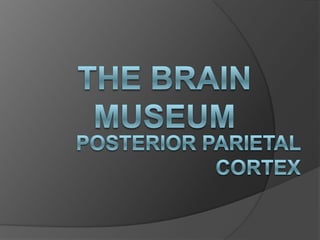
Posterior Parietal Cortex!
- 1. The brain museum Posterior Parietal cortex
- 2. Where is the Posterior Parential Cortex located in the Brain? The Posterior Parential Cortex is located in the portion of the parential lobe
- 3. What does this part of the brain do? Involved in the sensing and monitoring of body parts. Micro-electrode stimulation to the primary sensory cortex produces sensations in various parts of the body. Contains sensory association areas. Also integrates information from a different sensory areas to unable cross-model matching.
- 5. Studies involved with this part of the brain Lesion of posterior parietal cortex in rats does not disrupt place avoidance based on either distal or proximal orienting cuesAIM: if the role of the rat posterior parietal cortex in performing a place avoidance task. PROCEDURE: There were two groups of rats. The first groups brains were lesion in the posterior cortex area. The second group of rats were the control group. The rats were trained to avoid a certain sector in a maze. In the first maze the area they were to avoid has a rotating floor. In the second maze the area they were to avoid would give shocks if they entered RESULTS: showed that both the control and lesion rats were able to efficiently avoid both area. These results suggest that the posterior parietal cortex is not crucial for the processing of either proximal or distal cues in place avoidance.
- 6. Posterior Parietal Cortex Encodes Autonomously Selected Motor Plans by Richards A. Andersen AIM :The posterior parietal cortex (PPC) of rhesus monkeys has been found to encode the behavioral meaning of categories of sensory stimuli. When animals are instructed with sensory cues to make either eye or hand movements to a target, PPC cells also show specificity depending on which effector (eye or hand) is instructed for the movement. Study was conducted to determine whether this selectivity retrospectively reflects the behavioral meaning of the cue or prospectively encodes the movement plan PROCEDURE: Researher trained monkeys to autonomously choose to acquire a target in the absence of direct instructions specifying which effector to use. RESULTS :Activity in PPC showed strong specificity for effector choice, with cells in the lateral intraparietal area selective for saccades and cells in the parietal reach region selective for reaches. Such differential activity associated with effector choice under identical stimulus conditions provides definitive evidence that the PPC is prospectively involved in action selection and movement preparation.
- 7. TMS over the Left Posterior Parietal Cortex Prolongs Latency of Contralateral Saccades and Convergence Qing Yang1,2 and Zoï Kapoula1 AIM: This study explored the role of the left posterior parietal cortex (PPC) in saccades, vergence, and combined saccade–vergence movements by means of transcranial magnetic stimulation (TMS) in humans. METHODS. TMS was applied over the left PPC for 80, 90, or 100 ms after target onset. In a control experiment, TMS was applied over the primary motor cortex at 90 ms after target onset. RESULTS. Relative to no TMS trials, TMS over the left PPC increased the latency of only certain types of eye movements: saccades to right, convergence, and convergence combined with rightward saccades. It had no such effect on saccades to the left, divergence, saccades combined with divergence, or left saccades combined with convergence. TMS over the vertex had no effect on the latency of any type of eye movement. Thus, the effects of TMS on latency are both area- and eye-movement specific. TMS of the left PPC or the motor cortex did not alter the accuracy of any type of eye movement. The results are in contrast to those of prior studies of the right PPC, which is involved in the initiation of any type of eye movement. CONCLUSIONS. The findings suggest that the right PPC is involved primarily in the processing of fixation disengagement, whereas the left PPC provides the signal that is also necessary to initiate eye movements and could occur in parallel with the process (model of Findlay and Walker). Such a functional role of the left PPC seems to be topographically organized and concerns a saccade to the right and convergence alone or combined with a saccade to the right.
- 8. What happens when this part of the brain is dysfunctional? Damage to this area of the brain can lead to a syndrome called apraxia. Apraxia: patients can make certain gestures spontaneously but have trouble in making these same gestures if asked to do so. Apraxia: patients cannot make the correct movements to use objects such as a pencil or a pair of scissors, even though they can describe the functions of these objects perfectly.